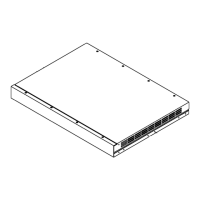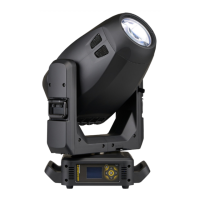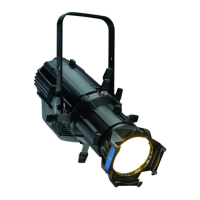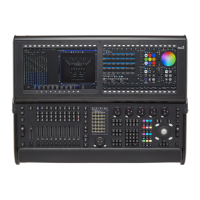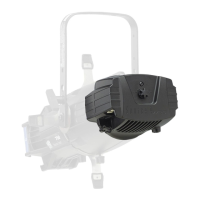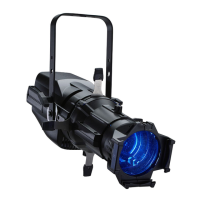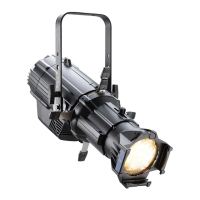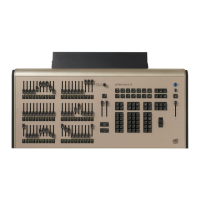Do you have a question about the ETC Express 24/48 and is the answer not in the manual?
Provides instructions for using the console's features and optional accessories.
Information about setting up your system, including Appendix A and Chapter 3.
Explains how to access help screens for console keys, softkeys, and wheels.
Describes console menu navigation techniques and visual feedback for choices.
Explains Highest Takes Precedence (HTP) and Latest Takes Precedence (LTP) rules.
Defines terms like fixtures, attributes, categories, and personalities for moving lights.
Explains the use of the 'Only' command to restrict selections during programming.
Details the console's trackpad operation in single, double, and XY modes.
Information on preserving console memory with an electronic backup system.
Guidance for resolving console problems and contacting ETC Technical Services.
Shows current levels of active channels on stage.
Allows working on cues, groups, submasters without affecting the stage look.
Isolates channels by A/B or C/D fader pairs, and displays background faders.
Shows only channels used in the show, reducing screen clutter.
Allows creation and modification of the dimmer-to-channel patch.
Configures the total number of dimmers available in the Patch display.
Reduces channel count to free console memory and improve processing time.
Assigns default upfade and downfade times for all cues.
Assigns a default value to the [Level] key.
Determines the fade time for both [Clear] keys.
Assigns a default time for the sneak function.
Enables or disables the console's [Blackout] key.
Sets the console's Command display to full or Flexichannel mode.
Configures the Master slider to Disabled, Grandmaster, Sub Grandmaster, or Scenemaster.
Disables the Record function to protect a finished show from changes.
Sets the console's operating mode to one scene or two scene.
Sets the console's real time clock and astronomical clock functions.
Assigns dimmer 1 to channel 1, dimmer 2 to channel 2, and so on.
Creates any dimmer to channel configuration.
Scales the output of individual dimmers to a lower level.
Assigns unpatched dimmers to channel zero.
Shows or hides labels assigned to dimmers in the Patch display.
Defines variable levels sent to a dimmer during a fade.
Assigns one of the 32 alternative profiles to a dimmer.
Displays a bar chart showing fade completion and intensity levels.
Raises unparked dimmers to a specified level on stage for checking.
Provides characteristics, patch, and use of individual dimmers.
Configures dimmers to increase controllable circuits of a dimming system.
Instructions for patching dimmers in a Strand CD80 dimmer rack.
Explains how channel color and behavior depend on their modes.
Channels with immediate control via keypad or level wheel.
Channels with levels set in Stage or Fader displays, taking precedence.
Channels recorded in a cue, group, focus point, or submaster.
Channel levels that change from one cue to the next.
Channels whose level is unchanged from the preceding cue.
Shows settings for every console channel: Independent, Flip, 16-bit, LTP, Label.
Details editing channels not patched to fixtures in the Channel Attributes display.
Makes a channel independent of Grandmaster, Flash, Release, Solo, and Blackout functions.
Reverses a channel's output, making it work in opposite directions.
Enables channels to contain 8-bit or 16-bit data.
Enables channels to operate in HTP or LTP mode.
Steps for selecting channels to modify their output levels.
Assigns output levels to channels using basic format [Channel] [#] [At] [#].
Sets channel levels using the trackpad.
Sets selected channel levels to the output level assigned to the [Level] key.
Sets selected channel's level to 100% or zero based on current level.
Fades channels on stage to a level or restores them to the last fader/submaster level.
Checks which channel controls which light by flashing a channel to a level.
Provides information about characteristics, patch, and use of individual channels.
Accesses menus for personality setup, fixture patch, attribute setup, and encoder setup.
Manages fixture personalities, including loading, viewing, deleting, and resetting defaults.
Installs fixtures in the Fixture Patch display, singly or in ranges.
Customizes assignment of fixture attributes to categories.
Changes assignment of fixture attributes to level-setting devices and pages.
Covers moving light displays and accessing the Fixture Box window.
Adjusts selected moving lights without interference from others.
Describes Crossfade, Allfade, Effect, Blocking, and Subroutine cue step types.
Explains the Record and Track functions for saving channel levels in cues.
Describes how to view stored cues live or in Blind mode.
Procedures for clearing stage and recording cues in Stage.
Steps to create, preview, or modify cues without affecting the current look on stage.
Records cues with custom fade times instead of default times.
Records cues with different upfade and downfade times.
Programs a wait time for the upfade or downfade before the fade begins.
Modifies cue sequence playback and plays multiple cues automatically.
Assigns labels to cues using Expression Off-Line.
Modifies channels in a recorded cue and affects the live look on stage.
Modifies previously recorded cues, groups, or submasters in Stage.
Deletes a cue from memory in Blind or Stage.
Uses a cue's channel levels as the foundation for a new cue, group, or submaster.
Inserts a new step in place of an existing one in an effect.
Records new cues or modifies existing ones, keeping levels unchanged.
Illustrates how Track works by creating five cues with channels.
Explains the difference between Record and Track when modifying cues.
Modifies tracked channels at a different level or focus point.
Manages tracking channels through cues, including the use of allfade cues.
Records one or more parts to a cue, with a maximum of eight parts per cue.
Reconfigures a single-part cue into a multipart cue.
Sets individual wait times for each part of a multipart cue.
Adds or deletes parts, channels, or modifies levels, fade, and wait times.
Removes a part from a multipart cue, transferring channels to part 8.
Edits channels within a multipart cue, including adding new ones.
Assigns fade and wait times to parts of a multipart cue.
Determines which cue will play next on stage using various methods.
Controls scenes and functions in reverse, allowing manual crossfades.
A short list of cues in the show, showing attributes and labels.
Provides information about cues loaded to faders, including times and rates.
Takes manual control of fade levels using fader sliders.
Controls fade rate and percentage of completion using the trackpad.
Runs through cues without waiting for fades; cues snap instantly.
Records frequently used channel combinations into units called groups.
Two modes: Group mode for recalling/modifying, Group Editing mode for creating/editing.
Procedures for displaying and modifying recorded groups on stage.
Assigns labels to groups using Expression Off-Line.
Deletes groups from memory in Stage, Blind, or Fader displays.
Copies a group's look from one submaster to another, cue, group, or focus point.
Treats channels recorded in a cue or submaster as if they were in a group.
Modifies cues or submasters using group channel levels.
Creates focus points using Stage, Blind, or Fader displays with various techniques.
Places or modifies recorded focus points on stage.
Modifies previously recorded cues, groups, submasters, or focus points in Stage.
Modifies focus points by adding/deleting fixtures or setting attribute levels.
Assigns labels to focus points using Expression Off-Line.
Deletes focus points from memory in Stage, Blind, or Fader displays.
Copies a focus point to another focus point, cue, group, or submaster.
Uses focus points to set channel or attribute levels, optionally preserving the link.
Describes Pile-on, Inhibitive, and Effect submaster types.
Changes a submaster's type using the [Type] key.
Manages submasters across ten pages of memory, increasing possible submasters to 240.
Explains the function of bump buttons and their status (enabled, disabled, solo).
Creates pile-on submasters in Stage or Blind mode.
Activates upfade, dwell, and downfade times for submasters via bump button.
Adds fade and dwell times to a submaster from Stage or Blind mode.
Fades up submaster, holds until bump button press, then holds until next press.
Converts a timed dwell to a manual dwell.
Records submasters that play back faster or slower than recorded fade times.
Specifies the page to which submasters are recorded.
Records submaster levels, excluding those from a specific cue, group, or submaster.
Limits channel output to a specified level set by the slider.
Edits submasters by entering channel numbers and setting new levels.
Modifies recorded submasters, cues, groups, or focus points in Stage.
Controls submaster timing via trackpad or keyboard entry.
Uses the slider to take manual control of submasters recorded with fade times.
Assigns labels to submasters using Expression Off-Line.
Copies a look from one submaster to another, cue, group, or focus point.
Loads contents of cues or groups into submasters.
Erases all level setting instructions and attributes from submasters.
Allows editing of fade times, link/follow settings, rate, and cue labels.
Edits one or multiple cues in the Cue List.
Allows editing of bump button status, times, type, rate, and label.
Makes changes to submasters in the Submaster List.
Removes recorded information from one or more submasters.
Shows recorded groups by number and label; allows paging, labeling, and deleting.
Deletes one or more groups from the Group List display.
Shows all focus points by number and label; allows paging, labeling, and deleting.
Deletes focus points from the Focus Point List display.
Explains spreadsheets for cues, submasters, groups, and focus points.
Allows tracking of cues created or modified.
Sets dimmers to a specified level on stage, and unparks them.
Parks channels at levels from keypad or at a focus point.
Parks channels, linking them to focus point levels for automatic updates.
Unparks one or all channels, returning levels to console assignment.
Parks cues, submasters, groups, or focus points at recorded or proportional levels.
Parks fixtures at levels set from keypad or at a focus point.
Unparks fixtures, returning attribute levels to console assignment.
Explains attributes, random rates, steps, channels, time, In, Dwell, Out, Lo, Hi.
Procedure for creating effects by specifying type and adding steps.
Builds effects in Stage while viewing results with captured channels.
Sets channel levels or adds channels to steps using Update in Stage or Blind.
Individually edits channels in a recorded effect cue using keypad or focus points.
Deletes channels from a previously created effect step.
Inserts a new step in place of an existing one, renumbering subsequent steps.
Deletes any step from an effect, causing other steps to be renumbered.
Sets effect attributes like Positive/Negative, Alternate, Reverse, Bounce, Build, Random.
Changes step timing and levels in a recorded effect.
Sets overall upfade, dwell, and downfade times for an effect.
Controls the range of randomness for an effect's rate.
Plays back effects recorded as cues, controlling them with faders.
Explains subroutine steps as cue steps or style steps.
Describes Crossfade, Allfade, and Blocking cue step types.
Describes Loop, Bounce, Jump-to-cue, and Hold-for-Go playback styles.
Creates subroutines by defining steps, levels, and playback styles.
Edits subroutine steps by selecting, changing fields, or using softkeys.
Deletes a step from a subroutine, renumbering remaining steps.
Inserts a blank step before a selected step in a subroutine.
Creates macros in Macro Editing mode or using the Learn mode.
Records keystrokes as macros by performing operations.
Creates or edits macros in Insert or Replace modes.
Clears individual or all macros from Macro display mode.
Copies macro contents from one macro to another.
Provides sample macros and references ETC's website for more.
Macro to bring each channel up to full for a channel check.
Determines trackpad control for channels used together.
Assigns channels to X and Y lists for trackpad control.
Inserts an empty link number ahead of a selected or specified link.
Renumbering a link or group of links to an empty space.
Adds channels from a moved link to an existing link.
Removes a link from the Link List, renumbering subsequent links.
Controls linked channels simultaneously on the trackpad.
Features for backing up, transferring, and managing shows on diskettes.
Erases all recorded information on a diskette.
Defines show and system configuration contents stored in a showfile.
Writes the current showfile to a diskette.
Reads show, system configuration, or both from a diskette.
Loads only show contents into memory, not system configuration.
Restores system configuration to one written previously to a diskette.
Verifies printer installation and availability.
Steps for printing various options from the Print Functions menu.
Lists all 17 options on the Print Functions menu and their printout explanations.
Brings up the Print Moving Lights menu with four printout options.
Erases information regarding console functions from memory.
General procedure for all clears and resets.
Lists and explains 14 options for clearing console functions.
Sets the console's operating mode to two scenes.
Explains A/B fader control of scenes and manual crossfades.
Shows current scene levels, time settings, and counts down fades.
Creates scenes and runs shows using manual crossfades.
Uses A/B fader controls to run timed crossfades between scenes.
Pauses or resumes a running timed crossfade.
Accesses dimmer monitoring system options.
Enables console to work with the ETCLink network.
Provides messages for conditions like fatal and secondary errors.
Shows system status: Double Firing Mode, Backup looks, ETCLink errors.
Provides information about specified dimmer racks.
Shows dimmer information: size, type, load, firing mode, curve, rack, slot.
Monitors individual dimmer loads for troubleshooting.
Lists dimmers with detected load errors.
Records load information for dimmers set at a level above zero.
Compares current dimmer loads with their recorded loads.
Clears recorded load information for selected dimmers.
Sets dimmers to a level at the rack or returns them to normal operation.
Saves and uses selected looks on stage as backup.
Allows console to transmit and receive MIDI messages.
Specifies the MIDI channel number for console operation.
Lists MIDI message formats used to control the console.
Recognizes and transmits MSC commands for console control.
Lists MSC commands the console accepts: Go, Stop, Resume, Fire.
Lists MSC commands the console sends to MIDI devices.
Creates programs that execute automatically based on time or conditions.
Enables or disables the real time programs feature.
Defines a time code program by entering events in the Time Code Events display.
Records macros, submaster bump buttons, and fader [Go] keys into time code events live.
Adds, changes, or deletes events in the Time Code Events display.
Controls up to 4 console macros from remote locations.
Disregards Serial Protocol Baud Rate option; reserved for future implementation.
Programs a macro to send On or Off signals to external devices.
Instructions for placing console, connecting power, and ventilation.
Steps for connecting the console, monitor, and power.
Explains ETC's local area networks and compatible interface devices.
Connects the console to a network hub or interface device using twisted pair wiring.
Resets starting dimmer numbers, sets ports for dimmer doubling, and adjusts DMX512 speed.
Attaches an alphanumeric keyboard to a peripheral device for assigning labels.
Installs parallel printers, including laser printers.
Installs the RFU for setting channel levels and checking dimmers remotely.
Connects the console to MIDI equipment using a standard MIDI cable.
Installs new console software from diskettes.
Covers installation of RIU and RVI devices.
Explains the use and installation of jumpers on circuit boards.
Details DIP switch and jumper settings for the RIU's main circuit board.
Instructions for inspecting and replacing RIU fuses.
Provides ports for remote accessories like monitors and keyboards.
Sets DIP switches to enable RVI for ETCNet network use.
Connects remote monitors to RIUs or RVIs operating on ETCNet.
Instructions for networking older consoles with thinnet wiring.
Lists common diskette errors and troubleshooting steps.
Details messages like 'Out of memory' and potential causes.
Categorizes ETCLink messages into fatal and secondary errors.
Messages that could terminate or drastically change the show's look.
Messages dealing with dimmer problems or rack temperature warnings.
Procedure to enable, disable, or selectively enable ETCLink advisories.
Lists recordings and settings pertaining directly to the show.
Lists settings that remain the same for all shows.
Retrieves configuration information included with show contents.
Retrieves configuration information from diskette.
Lists softkey functions available in the Stage and Stage 2 displays.
Lists softkey functions available in the Blind/Cue displays.
Softkey mappings for System Settings, Output Configuration, and Clear menus.
Softkey mappings for Print Functions and Options menus.
Softkey mappings for Macro Editing display.
Softkey mappings for ETCLink Functions and System Status.
Softkey mappings for Profiles and Channel Attributes displays.
Softkey mappings for Moving Light Functions menus.
Lists cities with their time zones, latitude, and longitude.
Lists cities outside the US with their time zones, latitude, and longitude.
Compares Express 24/48, 48/96, and 72/144 models.
Specifies voltage input and maximum current.
Lists interfaces like DMX512, printer, RFU, MIDI, ETCLink, and console lights.
Details capacity for cues, channels, dimmers, groups, macros, submasters.
Describes programmable fade times, manual override, rate, split, and manual fades.
Lists controls like faders, Go, Hold, Back, Rate, Clear, submasters, master, blackout, trackpad.
Covers internal/external clock, 12/24 hour timing, sunrise/sunset, and real time programs.
Details VGA output and online help displays.
Describes submaster pages, channel assignments, levels, bump buttons, and LEDs.
Covers data types, precedence, group function, channel selection, and link lists.
Details personalities, fixture patch, attribute setup, and encoder setup.
Covers cue capacity, fade times, linked cues, effect cues, and multipart cues.
Details group capacity, access, editing, and list.
Covers focus point capacity, access, updates, recording, and lists.
Details disk drive, show storage, software updates, and retrieval.
Covers macro capacity, editing modes, learn mode, and special functions.
Details effect capacity, live recording, editing, and attributes.
Describes profile assignment to dimmers and editable profiles.
Lists optional accessories like printer, RFU, and controller.
Provides dimensions and weight for Express 24/48, 48/96, and 72/144 models.
ETC's warranty for product defects under normal use.
Governing terms and conditions for orders accepted by ETC.
Index entries starting with numbers.
Index entries starting with the letter A.
Index entries starting with the letter B.
Index entries starting with the letter C.
Index entries starting with the letter D.
Index entries starting with the letter E.
Index entries starting with the letter F.
Index entries starting with the letter G.
Index entries starting with the letter H.
Index entries starting with the letter I.
Index entries starting with the letter J.
Index entries starting with the letter K.
Index entries starting with the letter L.
Index entries starting with the letter M.
Index entries starting with the letter N.
Index entries starting with the letter O.
Index entries starting with the letter P.
Index entries starting with the letter Q.
Index entries starting with the letter R.
Index entries starting with the letter S.
Index entries starting with the letter T.
Index entries starting with the letter U.
Index entries starting with the letter V.
Index entries starting with the letter W.
Index entries starting with the letter X.
Provides instructions for using the console's features and optional accessories.
Information about setting up your system, including Appendix A and Chapter 3.
Explains how to access help screens for console keys, softkeys, and wheels.
Describes console menu navigation techniques and visual feedback for choices.
Explains Highest Takes Precedence (HTP) and Latest Takes Precedence (LTP) rules.
Defines terms like fixtures, attributes, categories, and personalities for moving lights.
Explains the use of the 'Only' command to restrict selections during programming.
Details the console's trackpad operation in single, double, and XY modes.
Information on preserving console memory with an electronic backup system.
Guidance for resolving console problems and contacting ETC Technical Services.
Shows current levels of active channels on stage.
Allows working on cues, groups, submasters without affecting the stage look.
Isolates channels by A/B or C/D fader pairs, and displays background faders.
Shows only channels used in the show, reducing screen clutter.
Allows creation and modification of the dimmer-to-channel patch.
Configures the total number of dimmers available in the Patch display.
Reduces channel count to free console memory and improve processing time.
Assigns default upfade and downfade times for all cues.
Assigns a default value to the [Level] key.
Determines the fade time for both [Clear] keys.
Assigns a default time for the sneak function.
Enables or disables the console's [Blackout] key.
Sets the console's Command display to full or Flexichannel mode.
Configures the Master slider to Disabled, Grandmaster, Sub Grandmaster, or Scenemaster.
Disables the Record function to protect a finished show from changes.
Sets the console's operating mode to one scene or two scene.
Sets the console's real time clock and astronomical clock functions.
Assigns dimmer 1 to channel 1, dimmer 2 to channel 2, and so on.
Creates any dimmer to channel configuration.
Scales the output of individual dimmers to a lower level.
Assigns unpatched dimmers to channel zero.
Shows or hides labels assigned to dimmers in the Patch display.
Defines variable levels sent to a dimmer during a fade.
Assigns one of the 32 alternative profiles to a dimmer.
Displays a bar chart showing fade completion and intensity levels.
Raises unparked dimmers to a specified level on stage for checking.
Provides characteristics, patch, and use of individual dimmers.
Configures dimmers to increase controllable circuits of a dimming system.
Instructions for patching dimmers in a Strand CD80 dimmer rack.
Explains how channel color and behavior depend on their modes.
Channels with immediate control via keypad or level wheel.
Channels with levels set in Stage or Fader displays, taking precedence.
Channels recorded in a cue, group, focus point, or submaster.
Channel levels that change from one cue to the next.
Channels whose level is unchanged from the preceding cue.
Shows settings for every console channel: Independent, Flip, 16-bit, LTP, Label.
Details editing channels not patched to fixtures in the Channel Attributes display.
Makes a channel independent of Grandmaster, Flash, Release, Solo, and Blackout functions.
Reverses a channel's output, making it work in opposite directions.
Enables channels to contain 8-bit or 16-bit data.
Enables channels to operate in HTP or LTP mode.
Steps for selecting channels to modify their output levels.
Assigns output levels to channels using basic format [Channel] [#] [At] [#].
Sets channel levels using the trackpad.
Sets selected channel levels to the output level assigned to the [Level] key.
Sets selected channel's level to 100% or zero based on current level.
Fades channels on stage to a level or restores them to the last fader/submaster level.
Checks which channel controls which light by flashing a channel to a level.
Provides information about characteristics, patch, and use of individual channels.
Accesses menus for personality setup, fixture patch, attribute setup, and encoder setup.
Manages fixture personalities, including loading, viewing, deleting, and resetting defaults.
Installs fixtures in the Fixture Patch display, singly or in ranges.
Customizes assignment of fixture attributes to categories.
Changes assignment of fixture attributes to level-setting devices and pages.
Covers moving light displays and accessing the Fixture Box window.
Adjusts selected moving lights without interference from others.
Describes Crossfade, Allfade, Effect, Blocking, and Subroutine cue step types.
Explains the Record and Track functions for saving channel levels in cues.
Describes how to view stored cues live or in Blind mode.
Procedures for clearing stage and recording cues in Stage.
Steps to create, preview, or modify cues without affecting the current look on stage.
Records cues with custom fade times instead of default times.
Records cues with different upfade and downfade times.
Programs a wait time for the upfade or downfade before the fade begins.
Modifies cue sequence playback and plays multiple cues automatically.
Assigns labels to cues using Expression Off-Line.
Modifies channels in a recorded cue and affects the live look on stage.
Modifies previously recorded cues, groups, or submasters in Stage.
Deletes a cue from memory in Blind or Stage.
Uses a cue's channel levels as the foundation for a new cue, group, or submaster.
Inserts a new step in place of an existing one in an effect.
Records new cues or modifies existing ones, keeping levels unchanged.
Illustrates how Track works by creating five cues with channels.
Explains the difference between Record and Track when modifying cues.
Modifies tracked channels at a different level or focus point.
Manages tracking channels through cues, including the use of allfade cues.
Records one or more parts to a cue, with a maximum of eight parts per cue.
Reconfigures a single-part cue into a multipart cue.
Sets individual wait times for each part of a multipart cue.
Adds or deletes parts, channels, or modifies levels, fade, and wait times.
Removes a part from a multipart cue, transferring channels to part 8.
Edits channels within a multipart cue, including adding new ones.
Assigns fade and wait times to parts of a multipart cue.
Determines which cue will play next on stage using various methods.
Controls scenes and functions in reverse, allowing manual crossfades.
A short list of cues in the show, showing attributes and labels.
Provides information about cues loaded to faders, including times and rates.
Takes manual control of fade levels using fader sliders.
Controls fade rate and percentage of completion using the trackpad.
Runs through cues without waiting for fades; cues snap instantly.
Records frequently used channel combinations into units called groups.
Two modes: Group mode for recalling/modifying, Group Editing mode for creating/editing.
Procedures for displaying and modifying recorded groups on stage.
Assigns labels to groups using Expression Off-Line.
Deletes groups from memory in Stage, Blind, or Fader displays.
Copies a group's look from one submaster to another, cue, group, or focus point.
Treats channels recorded in a cue or submaster as if they were in a group.
Modifies cues or submasters using group channel levels.
Creates focus points using Stage, Blind, or Fader displays with various techniques.
Places or modifies recorded focus points on stage.
Modifies previously recorded cues, groups, submasters, or focus points in Stage.
Modifies focus points by adding/deleting fixtures or setting attribute levels.
Assigns labels to focus points using Expression Off-Line.
Deletes focus points from memory in Stage, Blind, or Fader displays.
Copies a focus point to another focus point, cue, group, or submaster.
Uses focus points to set channel or attribute levels, optionally preserving the link.
Describes Pile-on, Inhibitive, and Effect submaster types.
Changes a submaster's type using the [Type] key.
Manages submasters across ten pages of memory, increasing possible submasters to 240.
Explains the function of bump buttons and their status (enabled, disabled, solo).
Creates pile-on submasters in Stage or Blind mode.
Activates upfade, dwell, and downfade times for submasters via bump button.
Adds fade and dwell times to a submaster from Stage or Blind mode.
Fades up submaster, holds until bump button press, then holds until next press.
Converts a timed dwell to a manual dwell.
Records submasters that play back faster or slower than recorded fade times.
Specifies the page to which submasters are recorded.
Records submaster levels, excluding those from a specific cue, group, or submaster.
Limits channel output to a specified level set by the slider.
Edits submasters by entering channel numbers and setting new levels.
Modifies recorded submasters, cues, groups, or focus points in Stage.
Controls submaster timing via trackpad or keyboard entry.
Uses the slider to take manual control of submasters recorded with fade times.
Assigns labels to submasters using Expression Off-Line.
Copies a look from one submaster to another, cue, group, or focus point.
Loads contents of cues or groups into submasters.
Erases all level setting instructions and attributes from submasters.
Allows editing of fade times, link/follow settings, rate, and cue labels.
Edits one or multiple cues in the Cue List.
Allows editing of bump button status, times, type, rate, and label.
Makes changes to submasters in the Submaster List.
Removes recorded information from one or more submasters.
Shows recorded groups by number and label; allows paging, labeling, and deleting.
Deletes one or more groups from the Group List display.
Shows all focus points by number and label; allows paging, labeling, and deleting.
Deletes focus points from the Focus Point List display.
Explains spreadsheets for cues, submasters, groups, and focus points.
Allows tracking of cues created or modified.
Sets dimmers to a specified level on stage, and unparks them.
Parks channels at levels from keypad or at a focus point.
Parks channels, linking them to focus point levels for automatic updates.
Unparks one or all channels, returning levels to console assignment.
Parks cues, submasters, groups, or focus points at recorded or proportional levels.
Parks fixtures at levels set from keypad or at a focus point.
Unparks fixtures, returning attribute levels to console assignment.
Explains attributes, random rates, steps, channels, time, In, Dwell, Out, Lo, Hi.
Procedure for creating effects by specifying type and adding steps.
Builds effects in Stage while viewing results with captured channels.
Sets channel levels or adds channels to steps using Update in Stage or Blind.
Individually edits channels in a recorded effect cue using keypad or focus points.
Deletes channels from a previously created effect step.
Inserts a new step in place of an existing one, renumbering subsequent steps.
Deletes any step from an effect, causing other steps to be renumbered.
Sets effect attributes like Positive/Negative, Alternate, Reverse, Bounce, Build, Random.
Changes step timing and levels in a recorded effect.
Sets overall upfade, dwell, and downfade times for an effect.
Controls the range of randomness for an effect's rate.
Plays back effects recorded as cues, controlling them with faders.
Explains subroutine steps as cue steps or style steps.
Describes Crossfade, Allfade, and Blocking cue step types.
Describes Loop, Bounce, Jump-to-cue, and Hold-for-Go playback styles.
Creates subroutines by defining steps, levels, and playback styles.
Edits subroutine steps by selecting, changing fields, or using softkeys.
Deletes a step from a subroutine, renumbering remaining steps.
Inserts a blank step before a selected step in a subroutine.
Creates macros in Macro Editing mode or using the Learn mode.
Records keystrokes as macros by performing operations.
Creates or edits macros in Insert or Replace modes.
Clears individual or all macros from Macro display mode.
Copies macro contents from one macro to another.
Provides sample macros and references ETC's website for more.
Macro to bring each channel up to full for a channel check.
Determines trackpad control for channels used together.
Assigns channels to X and Y lists for trackpad control.
Inserts an empty link number ahead of a selected or specified link.
Renumbering a link or group of links to an empty space.
Adds channels from a moved link to an existing link.
Removes a link from the Link List, renumbering subsequent links.
Controls linked channels simultaneously on the trackpad.
Features for backing up, transferring, and managing shows on diskettes.
Erases all recorded information on a diskette.
Defines show and system configuration contents stored in a showfile.
Writes the current showfile to a diskette.
Reads show, system configuration, or both from a diskette.
Loads only show contents into memory, not system configuration.
Restores system configuration to one written previously to a diskette.
Verifies printer installation and availability.
Steps for printing various options from the Print Functions menu.
Lists all 17 options on the Print Functions menu and their printout explanations.
Brings up the Print Moving Lights menu with four printout options.
Erases information regarding console functions from memory.
General procedure for all clears and resets.
Lists and explains 14 options for clearing console functions.
Sets the console's operating mode to two scenes.
Explains A/B fader control of scenes and manual crossfades.
Shows current scene levels, time settings, and counts down fades.
Creates scenes and runs shows using manual crossfades.
Uses A/B fader controls to run timed crossfades between scenes.
Pauses or resumes a running timed crossfade.
Accesses dimmer monitoring system options.
Enables console to work with the ETCLink network.
Provides messages for conditions like fatal and secondary errors.
Shows system status: Double Firing Mode, Backup looks, ETCLink errors.
Provides information about specified dimmer racks.
Shows dimmer information: size, type, load, firing mode, curve, rack, slot.
Monitors individual dimmer loads for troubleshooting.
Lists dimmers with detected load errors.
Records load information for dimmers set at a level above zero.
Compares current dimmer loads with their recorded loads.
Clears recorded load information for selected dimmers.
Sets dimmers to a level at the rack or returns them to normal operation.
Saves and uses selected looks on stage as backup.
Allows console to transmit and receive MIDI messages.
Specifies the MIDI channel number for console operation.
Lists MIDI message formats used to control the console.
Recognizes and transmits MSC commands for console control.
Lists MSC commands the console accepts: Go, Stop, Resume, Fire.
Lists MSC commands the console sends to MIDI devices.
Creates programs that execute automatically based on time or conditions.
Enables or disables the real time programs feature.
Defines a time code program by entering events in the Time Code Events display.
Records macros, submaster bump buttons, and fader [Go] keys into time code events live.
Adds, changes, or deletes events in the Time Code Events display.
Controls up to 4 console macros from remote locations.
Disregards Serial Protocol Baud Rate option; reserved for future implementation.
Programs a macro to send On or Off signals to external devices.
Instructions for placing console, connecting power, and ventilation.
Steps for connecting the console, monitor, and power.
Explains ETC's local area networks and compatible interface devices.
Connects the console to a network hub or interface device using twisted pair wiring.
Resets starting dimmer numbers, sets ports for dimmer doubling, and adjusts DMX512 speed.
Attaches an alphanumeric keyboard to a peripheral device for assigning labels.
Installs parallel printers, including laser printers.
Installs the RFU for setting channel levels and checking dimmers remotely.
Connects the console to MIDI equipment using a standard MIDI cable.
Installs new console software from diskettes.
Covers installation of RIU and RVI devices.
Explains the use and installation of jumpers on circuit boards.
Details DIP switch and jumper settings for the RIU's main circuit board.
Instructions for inspecting and replacing RIU fuses.
Provides ports for remote accessories like monitors and keyboards.
Sets DIP switches to enable RVI for ETCNet network use.
Connects remote monitors to RIUs or RVIs operating on ETCNet.
Instructions for networking older consoles with thinnet wiring.
Lists common diskette errors and troubleshooting steps.
Details messages like 'Out of memory' and potential causes.
Categorizes ETCLink messages into fatal and secondary errors.
Messages that could terminate or drastically change the show's look.
Messages dealing with dimmer problems or rack temperature warnings.
Procedure to enable, disable, or selectively enable ETCLink advisories.
Lists recordings and settings pertaining directly to the show.
Lists settings that remain the same for all shows.
Retrieves configuration information included with show contents.
Retrieves configuration information from diskette.
Lists softkey functions available in the Stage and Stage 2 displays.
Lists softkey functions available in the Blind/Cue displays.
Softkey mappings for System Settings, Output Configuration, and Clear menus.
Softkey mappings for Print Functions and Options menus.
Softkey mappings for Macro Editing display.
Softkey mappings for ETCLink Functions and System Status.
Softkey mappings for Profiles and Channel Attributes displays.
Softkey mappings for Moving Light Functions menus.
Lists cities with their time zones, latitude, and longitude.
Lists cities outside the US with their time zones, latitude, and longitude.
Compares Express 24/48, 48/96, and 72/144 models.
Specifies voltage input and maximum current.
Lists interfaces like DMX512, printer, RFU, MIDI, ETCLink, and console lights.
Details capacity for cues, channels, dimmers, groups, macros, submasters.
Describes programmable fade times, manual override, rate, split, and manual fades.
Lists controls like faders, Go, Hold, Back, Rate, Clear, submasters, master, blackout, trackpad.
Covers internal/external clock, 12/24 hour timing, sunrise/sunset, and real time programs.
Details VGA output and online help displays.
Describes submaster pages, channel assignments, levels, bump buttons, and LEDs.
Covers data types, precedence, group function, channel selection, and link lists.
Details personalities, fixture patch, attribute setup, and encoder setup.
Covers cue capacity, fade times, linked cues, effect cues, and multipart cues.
Details group capacity, access, editing, and list.
Covers focus point capacity, access, updates, recording, and lists.
Details disk drive, show storage, software updates, and retrieval.
Covers macro capacity, editing modes, learn mode, and special functions.
Details effect capacity, live recording, editing, and attributes.
Describes profile assignment to dimmers and editable profiles.
Lists optional accessories like printer, RFU, and controller.
Provides dimensions and weight for Express 24/48, 48/96, and 72/144 models.
ETC's warranty for product defects under normal use.
Governing terms and conditions for orders accepted by ETC.
Index entries starting with numbers.
Index entries starting with the letter A.
Index entries starting with the letter B.
Index entries starting with the letter C.
Index entries starting with the letter D.
Index entries starting with the letter E.
Index entries starting with the letter F.
Index entries starting with the letter G.
Index entries starting with the letter H.
Index entries starting with the letter I.
Index entries starting with the letter J.
Index entries starting with the letter K.
Index entries starting with the letter L.
Index entries starting with the letter M.
Index entries starting with the letter N.
Index entries starting with the letter O.
Index entries starting with the letter P.
Index entries starting with the letter Q.
Index entries starting with the letter R.
Index entries starting with the letter S.
Index entries starting with the letter T.
Index entries starting with the letter U.
Index entries starting with the letter V.
Index entries starting with the letter W.
Index entries starting with the letter X.
| Brand | ETC |
|---|---|
| Model | Express 24/48 |
| Category | Lighting Equipment |
| Language | English |
